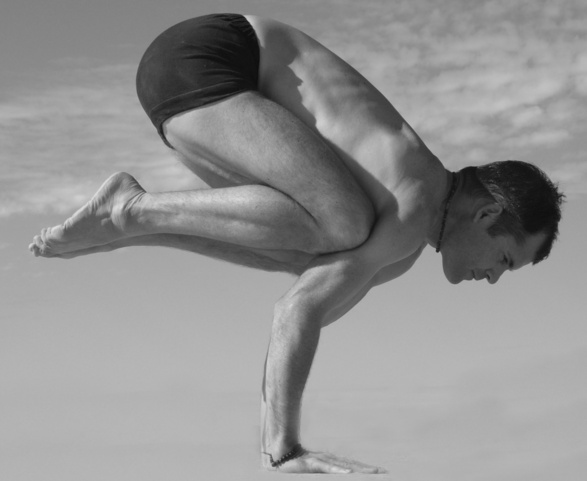
04 Jul Tias Little at Telluride Yoga Fest

Tias Little in Crow
The Sanskrit word “prajna” (from”pra” or before and the root “jna,” to know) can be variously translated as “wisdom,” “insight” ” profound understanding,” “discernment,” and “know-how.” In the Buddhist tradition, prajna connotes true or transcendental wisdom, one of the highest attainments of practice. In contrast to mere brain-mind ratiocination, prajna is a knowing that permeates the cells of our bodies.
Prajna Yoga is an holistic approach to practice and study that incorporates anatomy,Yoga and Buddhist meditation, Iyengar and Ashtanga principles of structure, alignment and movement, diet and the language of Yoga, Sanskrit. At their Santa Fe studio, Prajna Yoga, Tias and Surya Little celebrate the universal wisdom inherent in all things.
“The key to this teaching is that the purpose of the path of yoga is not to get outside of or away from one’s relationships in the world. Suggested in the weave of the Eternal Knot, the Prajna Yoga symbol, is to participate more wholeheartedly in life,” they say.
Tias and Surya Little, experts in all the riches the yoga tradition has to offer – asana (the poses), pranayama (controlled breathing or extension of the life force through the breath), svadhyaya (self study), chanting, and meditation, even nutrition, part of the ayurveda tradition, yoga’s twin – share their gifts at the 6th annual Telluride Festival, July 11 – July 14, 2013.
Tias Little was hardwired to know all that he knows profoundly. His mother Susan Little taught Iyengar and, in 1984, she began instructing Tias in that therapeutic lineage.
Tias combines the techniques of yoga that stem from the teaching of B.K.S Iyengar and Pattabhi Jois of Ashtanga Vinyasa Yoga. He specializes in yoga and anatomy, blending both Western and Eastern perspectives. He is also is a licensed massage therapist and his somatic studies have include in depth training in cranial-sacral therapy. His practice and teaching is influenced by the work of Ida Rolf, Moshe Feldenkreis and Thomas Hanna.
Tias is a long-time student of Tsoknyi Rinpoche in the Dzogchen practice of Tibetan Buddhism. He is trained in Vipassana meditation and Zen meditation.
Tias earned a Masters degree in Eastern Philosophy from St. John’s College Santa Fe in 1998. He is also author of two books: “The Thread of Breath” and “Meditations on a Dewdrop.”
At Yoga Fest, lessons from Tias Little’s classes include ways to use asana to strengthen the body and dharma study to gain insight into the mind and emotional body (“The Yogi and The Buddha”); how twists (standing, seated and supine) help bring energy and vitality to the body (“Twists: Stoking the Inner Fire”); how to access the subtle body and the subconscious through visualization and dream recall (“Yoga and the Dream Body”); and how to access the subtle body by helping to release the tongue, jaw, throat and inner ear (“Yoga for the Face, Eyes, Ears and Jaw”).

Surya Little
Surya Little’s path includes parallel studies in yoga and nutrition.
In 1987, she began her spiritual healing while living in Brienz, Switzerland at the Hairakhandi Babaji Ashram. Surya traveled to the foothills of the Himalayas of North India to practice bhakti and karma yoga within the community of her spiritual teacher, Hairakhand Babaji. Inspired to study food and healing and yoga as a way of life, in 1989 Surya studied with Dr. Vasant Ladd at the Ayurveda Institute in Albuquerque, New Mexico. She then moved to New York City in 1990 where she studied macrobiotic healing and later taught cooking classes at Gulliver’s Living and Learning Center (currently called Integrative Nutrition) run by Joshua Rosenthal and Marcie Zaroff.
Surya began her practice of Ashtanga Vinyasa Yoga with Eddie Stern at the Yoga Shala for two years. In 1992 she worked in Ryaad, Saudi Arabia where she cooked macrobiotic food and taught yoga for members of the Royal Family.
Currently she co-directs Prajna Yoga with Tias, teaching dynamic yoga, therapeutic yoga, cooking classes, and nutrition.
At the Telluride Yoga Fest, Surya Little asks the question “Should yoga practice be different for a woman?” and answers with a class that includes a practice to support women in all life phases of life, including pregnancy, menstruation, perimenopause and menopause (“Embodying the Feminine”). She also leads a class in balancing poses, both standing and arm balances, to increase vitality and raise the flame of heart energy (“Preparing the Ground, Building the Core”).
To learn more from Tias Little, click the “play” button and listen to our conversation.


Sorry, the comment form is closed at this time.